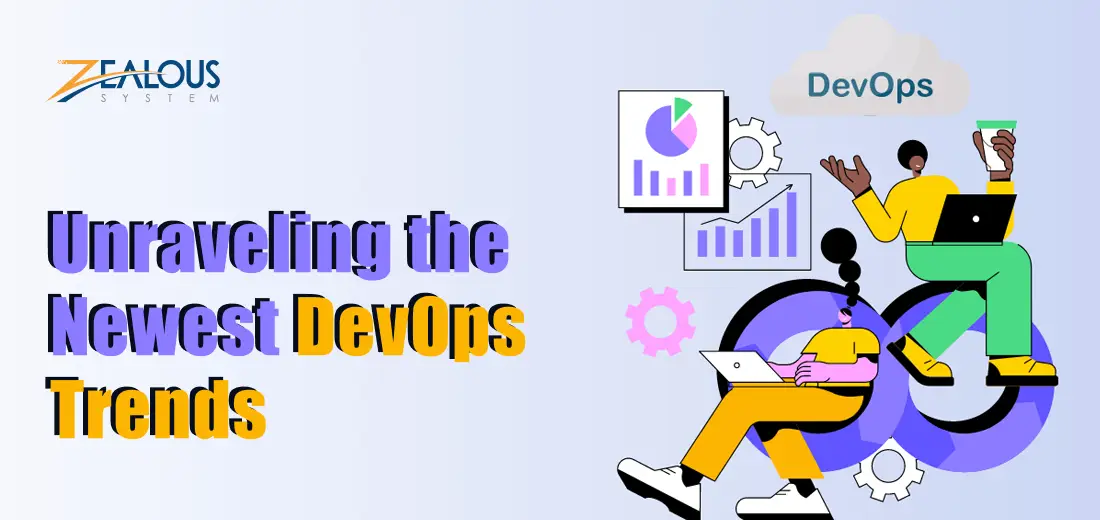


DevOps plays a key role in delivering applications efficiently and quickly. It connects development and operations teams, helping businesses release high-quality software faster and with fewer mistakes. As user demands grow, DevOps practices are essential for driving innovation, scalability, and reliability.
With advancing technology, the DevOps landscape is evolving. Trends like automation, AI, Kubernetes, and edge computing help businesses streamline workflows and speed up deployments. Companies that adopt these trends improve collaboration, shorten release cycles, and boost customer satisfaction, gaining a competitive advantage.
DevOps adoption has introduced tools, strategies, and frameworks that transform software delivery. Integrating security into pipelines and using machine learning for better performance are just a few examples. This blog explores 15 DevOps trends shaping the future of software development and IT operations.
Let’s first simply understand,
DevOps is a set of practices, cultural philosophies, and tools that facilitate collaboration between development (Dev) and operations (Ops) teams. The primary goal is to shorten the software development lifecycle while delivering high-quality applications continuously and reliably.
By implementing automation, continuous integration/continuous delivery (CI/CD), and monitoring tools, DevOps eliminates traditional silos between development and IT operations. It ensures faster deployments, fewer bugs, and increased efficiency. The core principles of DevOps—collaboration, automation, continuous improvement, and feedback—help organizations embrace agility and deliver seamless digital experiences.
As a software development company, we will uncover 15 impactful DevOps trends that are reshaping the way we approach software innovations.
Security is no longer an afterthought—it’s an integral part of the DevOps lifecycle. DevSecOps integrates security practices directly into CI/CD pipelines, ensuring vulnerabilities are addressed early. With automated security testing tools and compliance checks, DevSecOps promotes a “shift-left” approach to security.
This future DevOps trend shows a modern shift towards seeing security as a fundamental part of the entire development process. DevSecOps fits with the changing ways of doing things in DevOps by encouraging a proactive and teamwork-based approach to security. This helps organizations tackle potential security issues early on, making sure their software is strong and can handle potential threats.
Serverless computing enables developers to focus solely on writing code, abstracting away the complexities of infrastructure management. This DevOps trend allows for more efficient resource utilization and cost savings, making it an attractive option for organizations seeking scalability.
In alignment with current trends in DevOps, the adoption of serverless computing is on the rise. This trend reflects a contemporary approach to optimizing resource usage and minimizing costs, aligning with the evolving landscape of DevOps practices. As organizations continue to prioritize efficiency and scalability, the incorporation of serverless computing stands out as a noteworthy trend in the dynamic world of DevOps.
Microservices, breaking down monolithic applications into independently deployable services, align seamlessly with current DevOps trends. This combination emphasizes collaboration, automation, and continuous integration, fostering flexibility, scalability, and easier maintenance in modern software development.
In the context of DevOps trends, the adoption of microservices reflects a contemporary approach to software architecture, promoting enhanced collaboration and efficiency in the development and deployment processes.
AIOps, at the intersection of artificial intelligence and machine learning, is a pivotal element in current DevOps trends. This technology enhances IT operations by automating routine tasks and leveraging data analysis to identify patterns, predict issues, and streamline incident response.
In line with evolving DevOps trends, AIOps contributes to improved system reliability, aligning with the industry’s focus on collaboration, automation, and continuous improvement.
With the rise of low-code platforms, development becomes more accessible to non-programmers, marking a significant shift in future DevOps trends. This movement empowers business users to actively participate in application development, fostering collaboration and accelerating the delivery of applications.
This approach not only reduces the burden on development teams but also aligns with the evolving DevOps emphasis on inclusivity, efficiency, and rapid application deployment.
GitOps, extending the principles of DevOps, is a significant driver in current DevOps trends. By utilizing Git as the single source of truth for declarative infrastructure and applications, this approach simplifies version control, enhances traceability, and promotes collaboration between development and operations teams.
In the evolving landscape of DevOps, GitOps represents a forward-looking trend that aligns with the industry’s emphasis on versioning, transparency, and collaborative workflows.
Another widely-used DevOps trend is Kubernetes, an open-source platform that helps manage applications stored in containers. It is a key player in the current trends of DevOps, which focuses on automating tasks and efficiently managing infrastructure.
Kubernetes excels in automating the deployment, scaling, and operation of containerized applications, making it a crucial tool in the evolving DevOps landscape. Its strong and scalable foundation positions Kubernetes as a significant player in shaping the future of DevOps.
Docker, a containerization platform, helps developers bundle applications and their requirements into containers. These containers ensure uniformity across various environments, making it easier to deploy and scale applications seamlessly.
In the future trends of DevOps, Docker is a key player, promoting efficiency, portability, and the shift towards microservices architectures. It significantly contributes to the agility and scalability of software development and deployment.
Containerization separates applications from the infrastructure, making sure they deploy consistently across different settings. Containers are lightweight, easy to move, and can scale, which improves efficiency and consistency in DevOps workflows. Keeping up with ongoing trends in DevOps, containerization is vital. It brings flexibility, speeds up development, and supports a standardized approach to deploying applications.
As DevOps evolves, the use of containers remains a key trend, enhancing the optimization of software development and enabling smoother, collaborative, and efficient workflows.
Infrastructure as Code (IaC) is a method that automates and manages infrastructure using code. This helps maintain consistency, minimizes errors, and speeds up the setup and configuration of infrastructure parts. Looking ahead to future DevOps trends, IaC is expected to become more important.
As more companies adopt DevOps, the use of IaC is likely to grow, reflecting a move toward more efficient, scalable, and automated management of infrastructure, in line with the changing requirements of contemporary software development and deployment practices.
Cloud platforms offer flexible and readily available computing resources, making software development and deployment faster. When integrated with cloud services, organizations can use infrastructure and services without dealing with physical hardware. Following the latest trends in DevOps, the reliance on cloud platforms is expected to increase.
This smooth integration with cloud services aligns with the changing practices of DevOps, promoting agility, scalability, and efficiency in software development and deployment. As DevOps progresses, using cloud resources is likely to stay a significant trend, helping organizations achieve more adaptable and efficient development processes.
Site Reliability Engineering (SRE) uses software engineering principles for operations, creating reliable and scalable software systems. To keep systems performing well, SRE focuses on automation, monitoring, and responding to incidents. In the current trends of DevOps, SRE is becoming more important for building and maintaining strong systems.
The emphasis on automation, continuous monitoring, and effective incident response fits well with the changing DevOps landscape, helping create robust and dependable software setups. As DevOps evolves, using SRE principles is likely to continue growing, as they prove effective in ensuring and sustaining high system reliability.
In the face of growing cyber threats, it’s crucial to actively manage vulnerabilities. DevOps teams are stepping up by incorporating security practices, aiming to spot and fix vulnerabilities early in the development phase for an overall more secure system.
This aligns with current trends in DevOps, where a significant shift towards emphasizing security is observed. This shift reflects the changing landscape of DevOps and contributes to establishing a safer environment for development and deployment.
Cloud Native Infrastructure uses cloud services and containerization to create flexible and strong architectures. This method goes hand in hand with DevOps principles, which focus on being quick and using resources wisely.
As one of the latest trends in DevOps, more people are starting to prefer Cloud Native Infrastructure. This reflects a current shift towards architectures that are easy to manage and can adapt easily, showing how DevOps practices are evolving. As organizations aim for better efficiency, embracing Cloud Native Infrastructure is becoming a common practice in the ever-changing world of DevOps.
Cloud services cover a broad spectrum of functions, including data storage, computing power, databases, and machine learning solutions. DevOps teams tap into these services to make their operations more scalable, lessen the load of handling infrastructure, and speed up the release of products.
In keeping with the evolving trends in DevOps, there’s a noticeable uptick in the use of diverse cloud services. This shows a modern way of making things scalable, making infrastructure management easier, and getting new products and features out quickly. As DevOps keeps changing, using different cloud services is becoming a common practice, giving teams the tools they need to make their development and deployment processes smoother.
In conclusion, DevOps is a dynamic approach that integrates software development and IT operations, emphasizing collaboration, automation, and efficiency.
Current DevOps trends include DevSecOps for proactive security, serverless computing for resource optimization, and microservices architecture for flexibility. AIOps brings AI and ML to enhance IT operations, while low-code applications democratize development. GitOps, Kubernetes, Docker, and containerization streamline workflows, and Infrastructure as Code (IaC) automates infrastructure management. Cloud platforms, Site Reliability Engineering (SRE), vulnerability management, and Cloud Native Infrastructure showcase the industry’s commitment to scalability, reliability, and security.
As DevOps evolves, staying updated on these trends ensures organizations remain agile and competitive in the ever-changing tech landscape.
Read Also:
Our team is always eager to know what you are looking for. Drop them a Hi!
Comments